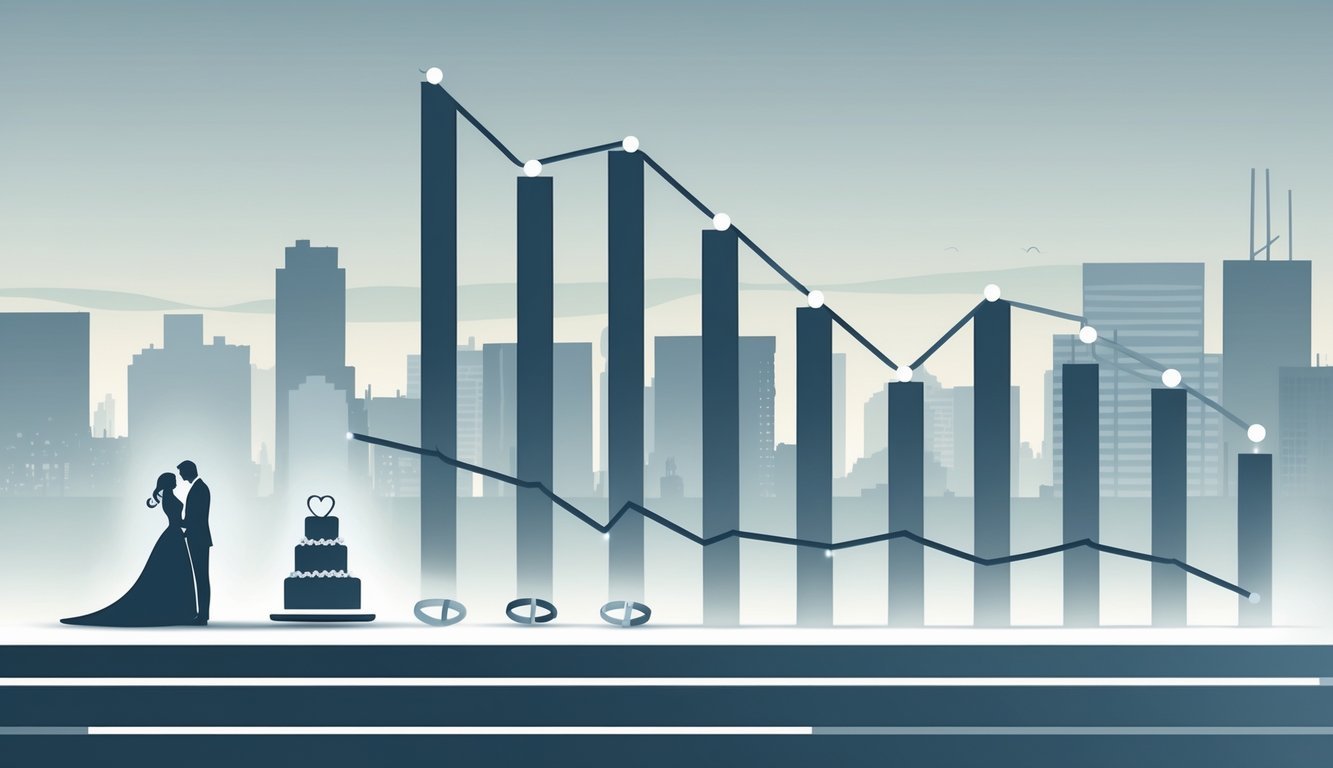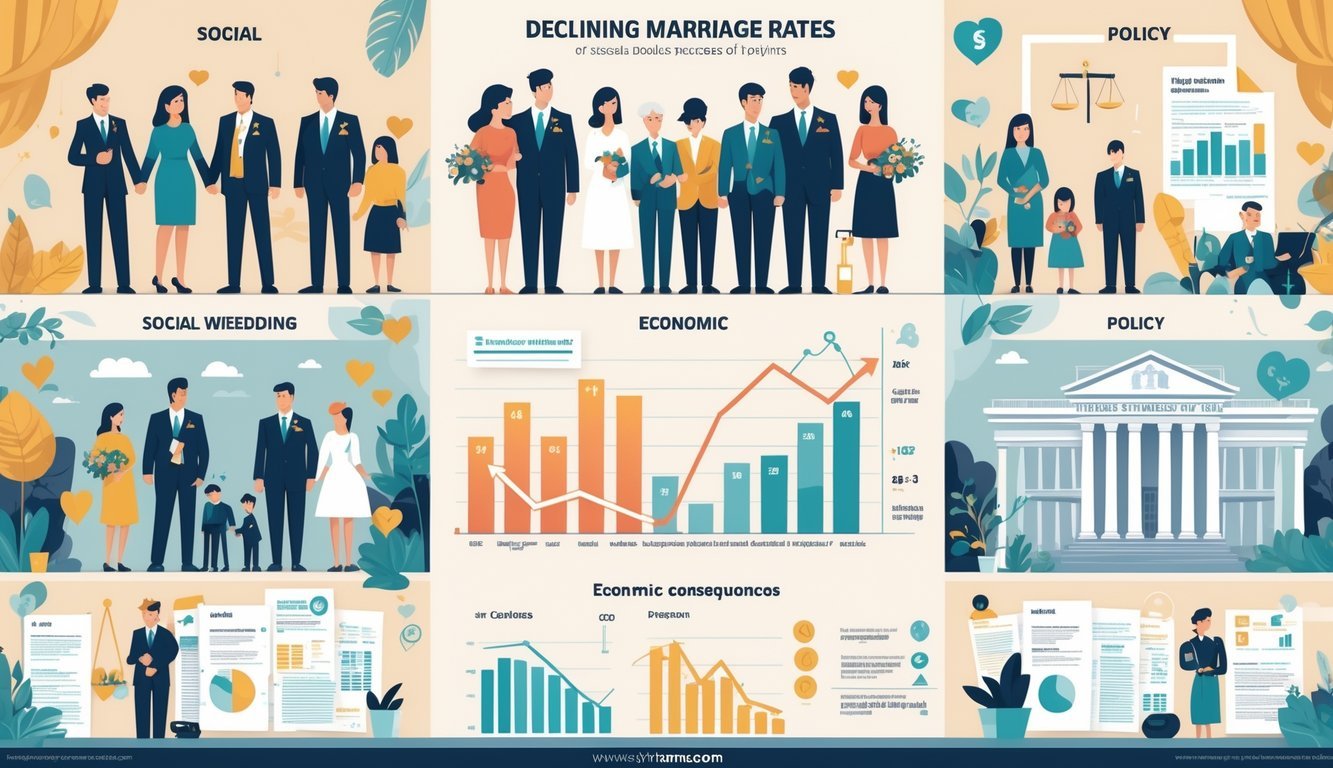PsychNewsDaily Publishers
100 Summit Drive
Burlington, MA, 01803
Telephone: (320) 349-2484
PsychNewsDaily Publishers
100 Summit Drive
Burlington, MA, 01803
Telephone: (320) 349-2484
Marriage rates in the U.S. have decreased by over 50% since 1900, influenced by economic struggles, changing social attitudes, and delayed marriage among younger adults.

Marriage rates in the U.S. have dropped sharply over the past century and keep falling today.
You might be surprised to learn that the marriage rate has fallen by more than half since 1900, and the last few years have seen some of the lowest numbers ever. Big changes in how people see marriage and relationships seem to drive this trend.
A lot of things play into this decline. Laws have changed, economic struggles are real, and social attitudes keep shifting.
The COVID-19 pandemic pushed rates down even further in some places, making the overall drop even sharper. Marriage rates just haven’t bounced back.
Trying to understand why marriage rates keep shrinking helps us see how society is changing. It also makes you wonder what partnerships and family life could look like in the future.
Let’s dig into the numbers and some of the main reasons behind this big shift.

Have you noticed fewer people getting married lately? Changing marriage patterns connect to shifts in age, social habits, and differences among groups in the U.S.
Marriage rates in the U.S. have dropped steadily for decades. In 2021, there were about 14.9 marriages per 1,000 women—down from 16.3 in 2011.
The American Community Survey and National Vital Statistics show that fewer couples are choosing to marry. These numbers match global trends, where more people either delay marriage or skip it altogether.
The U.S. Census Bureau backs this up. Marriage just isn’t as central as it once was.
When you marry matters a lot. More people now wait until later in life to tie the knot.
Delaying marriage gives you time for school, careers, or just figuring yourself out. But it also means fewer people end up getting married at all.
Studies on marital history show that as the age at first marriage rises, marriage rates go down. Seems like priorities and social norms are shifting right along with it.
Marriage rates don’t look the same for everyone. They change depending on race, education, income, and where you live.
When you look at these differences, it’s clear that national trends don’t hit every group the same way. Your background and community might shape your experience with marriage.

Dropping marriage rates touch a lot of parts of American life. Family structures change, poverty and inequality shift, and government rules about benefits have to adapt.
These changes might show up in your neighborhood or even your own family.
Marriage just isn’t as common, especially for folks with lower incomes. More people are living together or raising kids without getting married.
This changes family setups, so there are fewer two-parent households.
When fewer couples marry, family stability can look different. Married couples often pool resources and support each other financially.
This can shape how kids grow up and what chances they get later on.
Divorce and widowhood also change family structures. Divorce rates have shifted but still matter, and a lot of older adults deal with widowhood.
These changes affect who takes care of family members and how families support each other.
Fewer marriages often mean more inequality. Married couples usually combine incomes, which helps keep families out of poverty.
When fewer people marry, more families—especially single-parent ones—face money problems.
Melissa Kearney and other researchers point out that this “marriage gap” lines up with income inequality. People with fewer opportunities marry less, and that can trap families in poverty.
This just makes wealth gaps between communities wider.
Poverty hits single-parent families hardest. A lot of social programs assume two-parent homes, so when that’s not the case, some families have a tougher time getting help.
Marriage trends shift with education and race. People with college degrees tend to marry more than those without.
This difference shows up in neighborhoods and schools, making social and economic divides even more obvious.
Race and ethnicity matter too. Black and Hispanic families often have different marriage patterns compared to White families.
History and social forces play a big part in this.
Because of these differences, kids’ home lives can be all over the map depending on their family’s education and race. That shapes what resources they get and their chances for success.
U.S. policies often give married couples a leg up. Social Security, tax breaks, and healthcare can be easier to get when you’re married.
This “two-parent privilege” means marriage brings some real economic perks.
With fewer marriages, these policies sometimes leave unmarried families with less support. Divorce and changes in marital status affect who gets benefits.
The Survey of Income and Program Participation (SIPP) shows a lot of families feel the impact of these policy changes.
Political leaders, including Donald Trump during his presidency, have talked about marriage and family in policy debates.
Laws around welfare and family benefits try to keep up, but they don’t always match new family realities.
If you’re single or in an unmarried partnership, it’s important to know how policy can affect your access to support. These rules can change what your family gets, especially when you really need it.

Marriage rates have dropped a lot, and honestly, there’s no single reason for it. People are waiting longer, fewer young adults are tying the knot, and society just doesn’t see marriage the same way anymore.
Younger adults often delay marriage to focus on education or work. Some just prefer living together without the paperwork.
Higher education, financial worries, and changing social values all make marriage less common. People also tend to marry later now.
Marriage rates keep dropping, especially for adults under 35. The percentage of married young adults is way down compared to a few decades ago.
Absolutely. A lot of people don’t see marriage as necessary for a committed relationship anymore. Traditional views just aren’t as strong.
Lower marriage rates can change how families form and affect support systems. It might also impact economic stability for some people.
Fewer people are getting married these days, but divorce rates haven’t really changed much. Researchers have noticed that folks tend to divorce later in life now, or after being married for a longer time.
It’s an interesting shift, isn’t it?